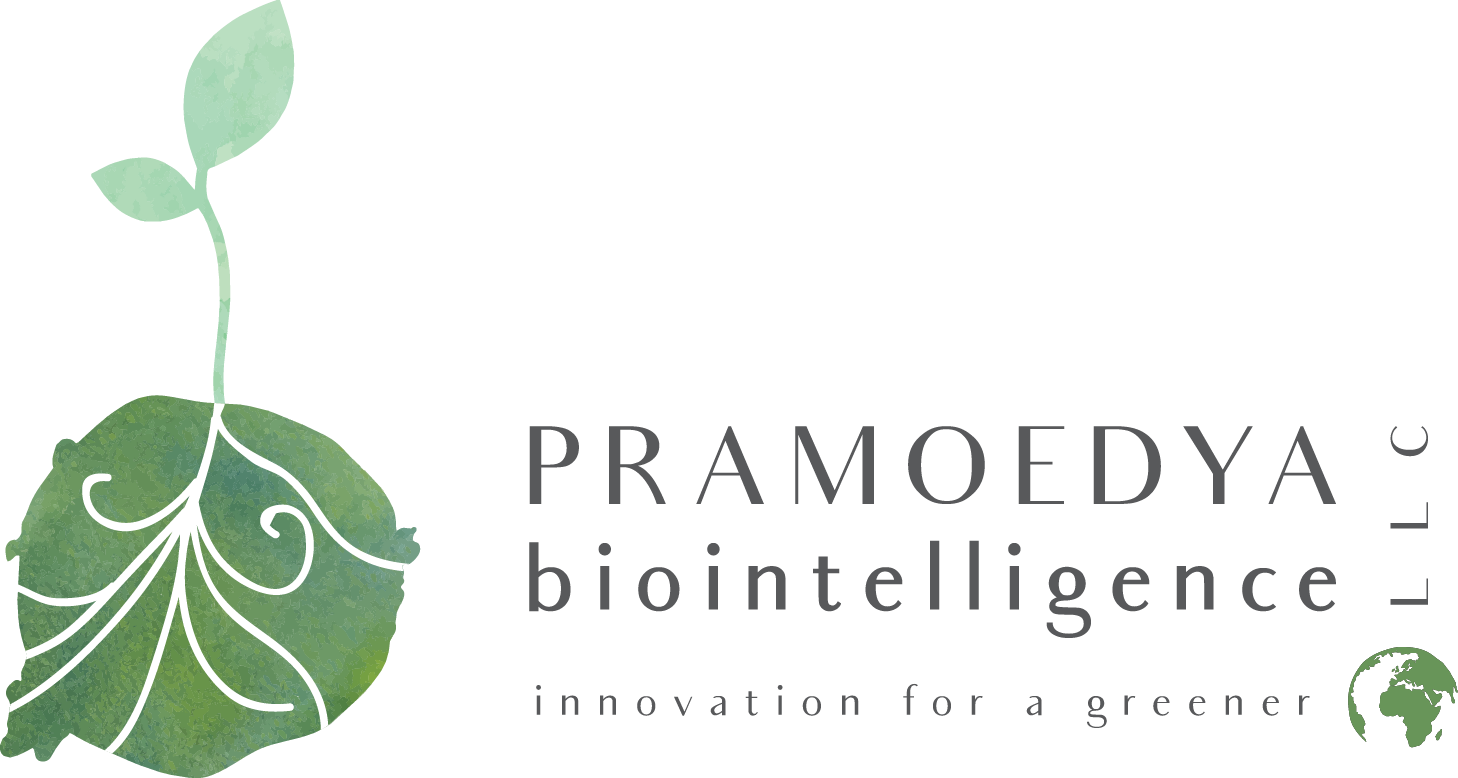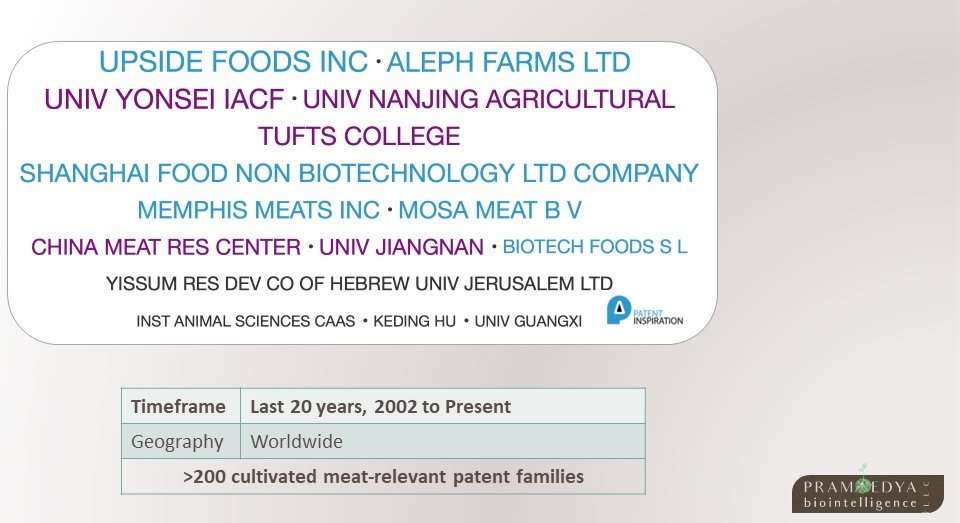Cultivated Meat Technology and Patent Landscape
Competitive landscape assessment
Insights for better business decisions
What is Cultivated Meat?
•Compared to plant-based meats, cultivated meat has high potential to create meat products that could truly mimic the texture and organoleptic properties of animal meats, especially unprocessed meats (e.g. steaks).
•This concept has been mentioned as early as in the 1930s by Sir Winston Churchill, but is only beginning to gain traction within the past few years.
•Many companies (e.g. Upside Foods and Mosa Meat) have made encouraging progress to date.
•However, the field is still in an early stage.
•The first few regulatory approvals have been granted in Singapore ( in 2020, 2021) and US (in 2022 and 2023).
•Current challenges include creating the best-tasting meat with good texture, cost reduction and production scalability.
Below, we provide a brief overview of the cultivated meat patent dataset, and examples of interesting emerging concepts.
Our questions:
•How does the cultivated meat patent landscape look like?
•Who are the key players?
Who are the academic players?
How does the patent portfolio of the key players look like?
•What are the key patent topics?
•What are the main technical challenges and solutions?
A. Cultivated Meat Patent Publications Overview
>200 cultivated meat-relevant patent families were retrieved
Text mining analysis reveals challenges and solutions
A large proportion of the keywords concern the growth/cultivation of cultivated meat. Additional concepts revealed include scaffold, serum-free media, and fat cells.
Key worldwide cultivated meat patent players
consist of both companies and academic institutions.
B. Patent Examples
Growth methods of cultivated meat products
A significant fraction of the patent covers the growth and cultivation methods (cell types, growth conditions and methods) to create the cultivated meat products. Patent US2022110347A1, by Upside Foods, describes apparatuses and systems to prepare meat products at a larger scale, which includes the growth and differentiation of the cell lines and recovery of the desired meat products.
Media and growth reagent development
One of the key challenges for cultivated meat is to create the desired products without the use of animal-sourced ingredients, such as fetal bovine serum. Another key driver for such media is cost reduction. One common class of patents concerns inventions related to the media and growth reagents. Patent WO2022125809A1, by Tufts University, describes growth media that is serum- and animal-free for the expansion of muscle satellite cells.
Scaffolding
A significant fraction of the patent dataset describes scaffolding technologies required to create cultured meat products. Scaffolding is critical so that different cell types could be co-cultured to achieve the desired meat texture. Diverse concepts are revealed in this class of patents, including many plant-based and food-safe scaffold solutions. Patent WO2022162662A1, by Aleph Farms, describes a 3-D edible and protein-enriched scaffold for cultured meat applications.
Cell-based Fat
Animal fat plays an important role in our enjoyment of animal meat. As animal fats have very different properties from plant-based fats, e.g. animal fats are solid at room temperature, while plant-based fats in general are liquid at room temperature, innovation in cell-based fats, and how they could be incorporated into cultured meat or be co-cultured is critical to the success of cultivated meat. Patent WO2021207293A1, by Mission Barns, describes scalable bioreactor systems for the production of cell-based meat and cell-based fat.
C. Summary
1. The cultivated meat patent dataset consists of at least 200 patent families. A significant fraction of the patents were published within the last several years. This novel field is rapidly expanding its innovation activities. More than half (N~120) of the patent families are Chinese patent publications.
2. The key patent players include companies (e.g. Mosa Meat, Upside Foods (former Memphis Foods) and Shanghai Food Non Biotechnology). There are also key players from academic institutions (Tufts University and University of Yonsei IACF in Korea).
3. The patent dataset consists of diverse scientific topics: cell lines, culture media, growth conditions, bioreactor design, scaling up and scaffolding technologies. There seems to be a unifying underlying concept targeted by these diverse topics: the growth and cultivation of the cultivated meat products. This suggests that the field is still in an early stage: main challenge remains to create a product that best mimics animal meat.
4. Interesting concepts within the dataset:
Product cultivation method (e.g. Patent US2022110347A1, by Upside Foods)
Culture media that is serum- or animal-free for both animal welfare and cost-cutting purposes (e.g. patent WO2022125809A1, by Tufts University)
Scaffold to cultivated cultured meats ( e.g. Patent WO2022162662A1 by Aleph Farms)
Cell-based fats (Patent WO2021207293A1 by Mission Barns)
BIoreactor designs (for upscaling purposes)
How could we help you?
Here, we provide a high-level snapshot of the cultivated meat landscape.
Innovation and Patent Analytics Opportunity for further exploration:
Cross-industry learning: Tissue engineering for cultivated meat is essentially a subsegment of regenerative medicine, and could benefit from advances in regenerative medicine or ES/pluripotent stem cell differentiation.
Company profiles for benchmarking analysis
Segmentation of the dataset by variables (e.g. patent topics) for insights generation or innovation white space identification
This is distinct from an actual consulting assignment/report, where we dive deeper into specific deliverables to extract actionable insights. An assignment is usually a multi-faceted competitive intelligence exercise, where insights from patent landscape study represent only a slice of the information pie.
Last Update: December 9, 2022














